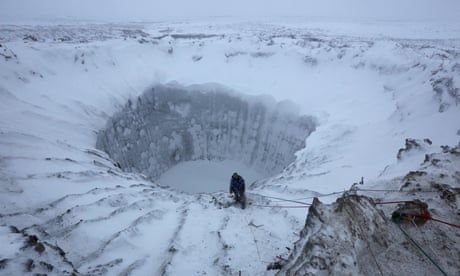
Study finds craters come from forceful releases of methane gas from underground ponds as temperatures warm
In 2014 a mysterious crater suddenly appeared on the Yamal peninsula in north-west Siberia. The debris surrounding this 50-metre-deep hole suggested it had been produced by an explosive process. Since then, scientists and local people have discovered several more craters on the Yamal and nearby Gydan peninsulas and a multitude of explanations have been put forward, ranging from meteor impacts to natural gas explosions. Now a new study has revealed the cause.
Drill down through the seasonally frozen soil in this region and you reach a thick clay permafrost layer. Sandwiched between the soil and permafrost lie unusual metre-thick ponds of very salty water known as cryopegs, which are underlain by crystalised methane-water solids, kept stable by the high pressure and low temperature.
Continue reading...